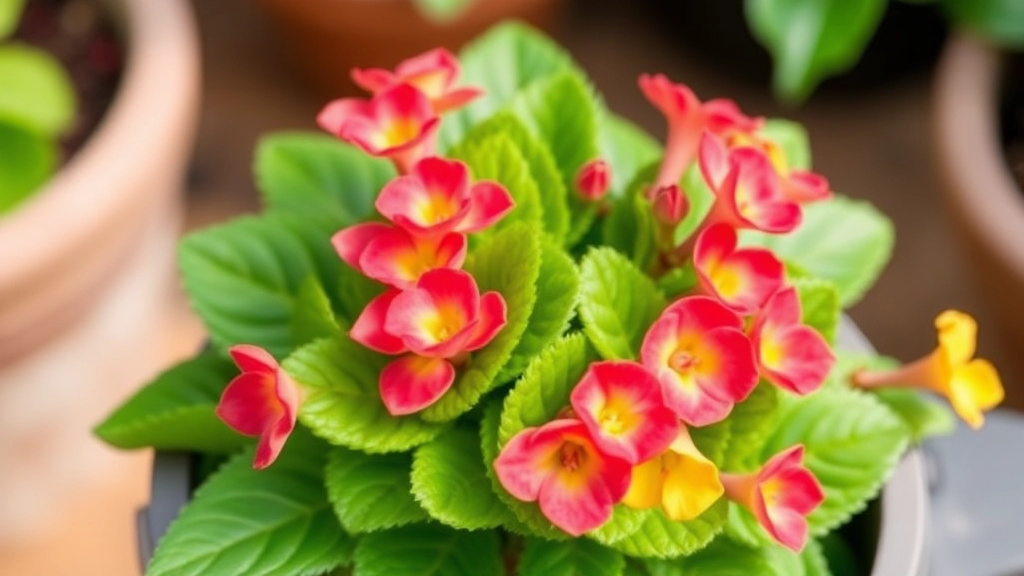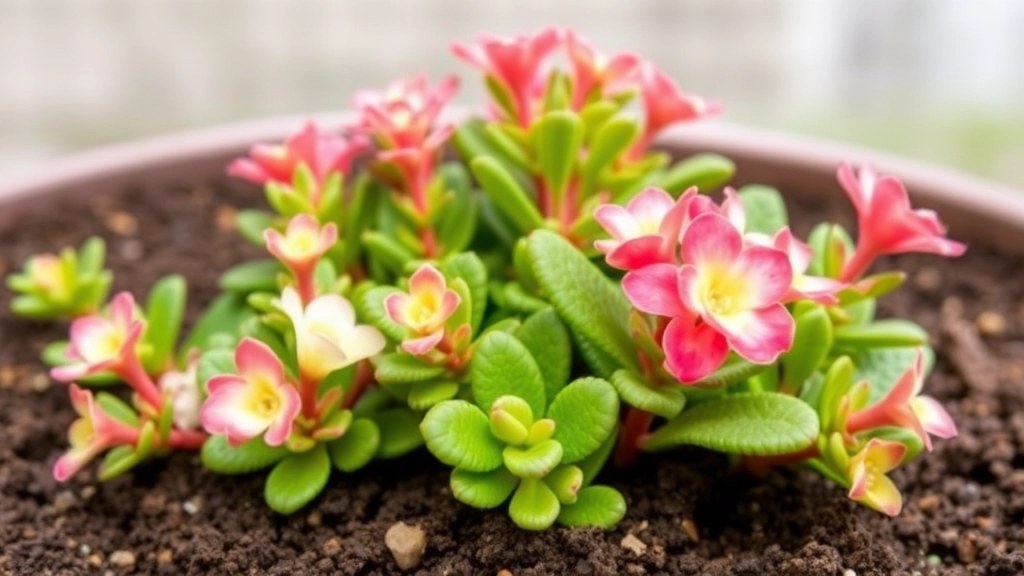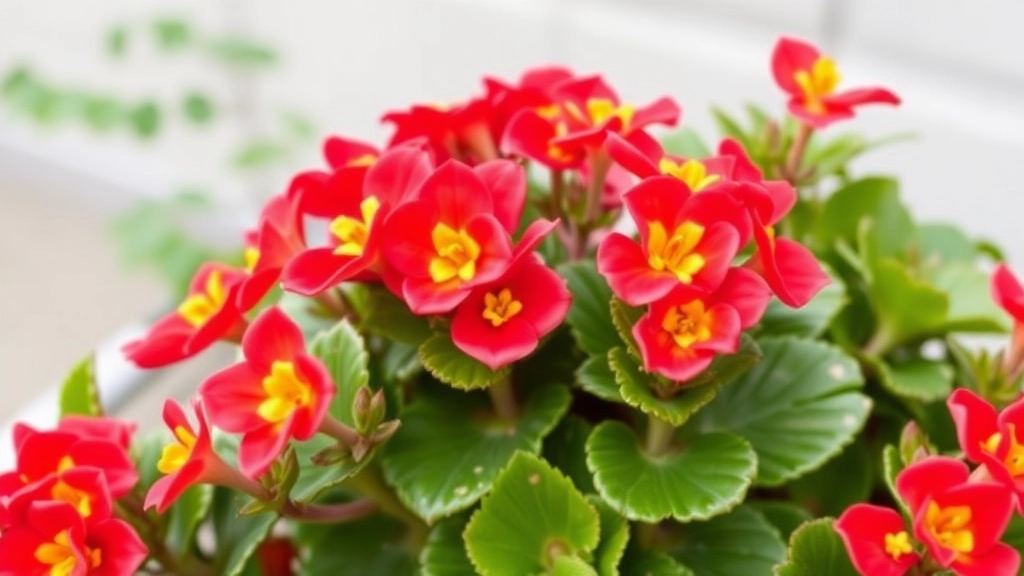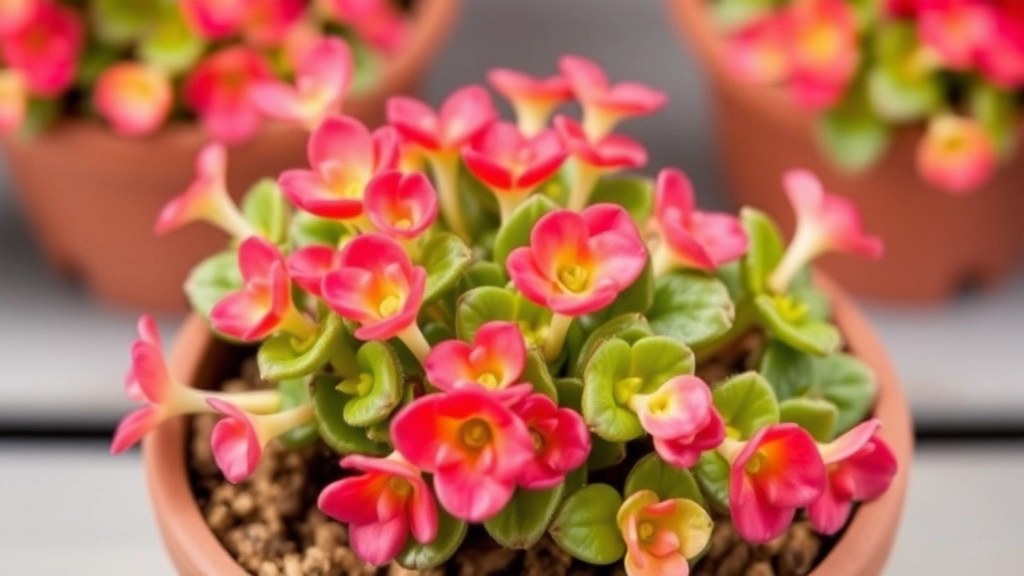Kalanchoe Plant Care
Taking care of a Kalanchoe plant can be incredibly rewarding, especially when you see those vibrant blooms flourish. To get started with Kalanchoe plant care, you’ll need to focus on a few key areas: sunlight, watering, temperature, soil, and fertilization. Each of these elements plays a crucial role in ensuring your plant thrives both indoors and outdoors.
Light Requirements
First and foremost, Kalanchoes love bright, indirect sunlight. Position your plant near a sunny window but avoid direct sun exposure, which can scorch the leaves.
Watering
When it comes to watering, less is more. Allow the soil to dry out completely between waterings to prevent root rot.
Temperature and Humidity
Ideal temperature ranges from 15-24°C, and they prefer low humidity.
Soil and Fertilization
Use well-draining soil and fertilize sparingly during the growing season to encourage lush growth and vibrant blooms. With these tips, your Kalanchoe will be a stunning addition to your plant collection.
Best Sunlight Conditions for Kalanchoe Growth
Are you struggling to keep your Kalanchoe thriving?
The right sunlight conditions can make all the difference in your plant’s health and vibrancy.
Understanding Kalanchoe’s Light Needs
Kalanchoe plants are native to Madagascar, which means they thrive in bright, indirect sunlight. Here’s how to ensure your Kalanchoe gets just the right amount of light:
- Bright Indirect Light: Place your Kalanchoe near a window where it can receive bright, indirect sunlight for most of the day.
- Avoid Direct Sunlight: While Kalanchoe enjoys light, direct sunlight can scorch its leaves. If you notice browning or wilting, it may be getting too much sun.
- Rotate Your Plant: To promote even growth, rotate your Kalanchoe every few weeks. This helps all sides receive adequate light.
Signs Your Kalanchoe is Happy
How can you tell if your Kalanchoe is enjoying its light conditions? Look for these signs:
- Vibrant Leaves: Healthy, green leaves indicate your plant is receiving sufficient light.
- Frequent Blooms: If your Kalanchoe is flowering, it’s a good sign that it’s happy in its light environment. For more tips on encouraging blooms, check out our guide to optimal blooms.
Seasonal Adjustments
As seasons change, so should your Kalanchoe’s light exposure. During winter, when sunlight is less intense, you might need to move your plant closer to the window. For additional winter care tips, visit our winter care guide.
Ideal Watering Schedule for Healthy Kalanchoe

So, you’ve got your Kalanchoe all set up, and now you’re wondering, “How much water does my plant really need?” It’s a common worry among plant parents, and rightly so! Overwatering or underwatering can be the difference between a thriving plant and a sad, droopy one.
How Often Should You Water?
Kalanchoes are succulents, which means they store water in their leaves. This makes them a bit more forgiving when it comes to watering. Here’s a simple breakdown:
- In Spring and Summer: Water every 2-3 weeks.
- In Autumn and Winter: Cut back to once a month.
Signs Your Kalanchoe Needs Water
Keep an eye out for these signs:
- Dry Soil: If the top inch of the soil feels dry, it’s time to water.
- Wrinkled Leaves: This can indicate your plant is thirsty.
Watering Techniques
When it’s time to water, here’s how to do it right:
- Soak the Soil: Water thoroughly until you see it draining from the bottom.
- Avoid the Leaves: Try not to get water on the leaves to prevent rot.
Tips for Watering
- Use Room Temperature Water: This is easier on the plant.
- Check the Pot: Make sure your pot has drainage holes to prevent waterlogging.
When it comes to nurturing your Kalanchoe, understanding its temperature and humidity requirements is crucial.
### Ideal Temperature Range
Kalanchoe plants thrive best in temperatures between **18°C to 24°C** (65°F to 75°F).
– **Indoor Conditions**: Keep your Kalanchoe away from drafty windows or heating vents. Ideal indoor temperatures should remain stable, avoiding extremes.
– **Outdoor Conditions**: If you’re growing Kalanchoe outside, ensure they are sheltered from frost. They can tolerate warmer conditions but prefer a bit of shade during the hottest part of the day.
### Humidity Levels
Kalanchoe plants are quite adaptable when it comes to humidity.
– **Low Humidity**: They can thrive in low humidity environments, making them perfect for most homes.
– **High Humidity**: If you live in a more humid area, ensure good air circulation around your Kalanchoe to prevent mold and mildew.
### Tips for Maintaining Ideal Conditions
– **Monitor Temperature**: Use a thermometer to keep an eye on indoor temperatures.
– **Humidity Control**: If humidity is too high, consider using a dehumidifier or placing your Kalanchoe in a well-ventilated space.
– **Seasonal Adjustments**: Be mindful of seasonal changes. In winter, you may need to move your Kalanchoe closer to a light source to maintain warmth.
For more detailed guidance on growing Kalanchoe outdoors, check out our [Outdoor Kalanchoe Growing Tips](https://planthq.org/outdoor-kalanchoe-growing-tips-expert-guide-for-florists/). Additionally, if you’re interested in maintaining vibrant blooms, our [Essential Fall Kalanchoe Care Tips](https://planthq.org/essential-fall-kalanchoe-care-tips-for-healthy-blooms/) can provide valuable insights.
Choosing the Right Soil for Kalanchoe Plants

When it comes to nurturing your Kalanchoe, the right soil can make all the difference. You might be wondering, “What type of soil does my Kalanchoe really need?” Let’s dive into the essentials of soil selection to ensure your plant thrives.
Key Soil Characteristics
- Well-Draining: Kalanchoe plants prefer soil that drains well. This prevents root rot, a common issue for these succulents.
- Lightweight Texture: Opt for a soil mix that is light and airy. This allows for proper aeration, which is crucial for healthy root development.
- pH Level: Aim for a slightly acidic to neutral pH, typically between 6.0 and 7.0. This range supports optimal nutrient uptake.
Recommended Soil Mixes
You can either purchase a pre-made succulent or cactus mix or create your own. Here’s a simple recipe:
- 1 part potting soil
- 1 part perlite or pumice
- 1 part coarse sand
This blend provides excellent drainage while retaining some moisture.
Tips for Soil Maintenance
- Avoid Heavy Soils: Steer clear of garden soil or any mix that retains too much moisture.
- Repotting: Every couple of years, consider repotting your Kalanchoe to refresh the soil and provide more room for growth.
- Watch for Compaction: If you notice the soil becoming compacted, it may be time to refresh or replace it.
Effective Fertilization Techniques for Optimal Blooms
As we delve deeper into nurturing your Kalanchoe, it’s crucial to consider how fertilization plays a significant role in achieving vibrant blooms.
Understanding Kalanchoe Nutritional Needs
Many plant enthusiasts often wonder how to provide their Kalanchoe with the right nutrients.
Key Fertilization Tips:
- Use a Balanced Fertilizer: Opt for a water-soluble fertilizer with equal parts nitrogen, phosphorus, and potassium (NPK 20-20-20). This ensures your plant receives all essential nutrients.
- Frequency Matters: Fertilize every 4-6 weeks during the growing season (spring and summer). This helps promote healthy growth and abundant flowers.
- Dilution is Key: Always dilute the fertilizer to half the recommended strength. Kalanchoe is sensitive to over-fertilization, which can lead to root burn.
- Consider a Bloom Booster: In the lead-up to flowering, switch to a fertilizer higher in phosphorus (NPK 10-30-20) to encourage more blooms.
- Soil Testing: Test your soil occasionally. This helps you understand nutrient levels and adjust your fertilization routine accordingly.
Signs of Nutrient Deficiency:
- Yellowing Leaves: Indicates a lack of nitrogen.
- Poor Flowering: Could suggest insufficient phosphorus.
By paying attention to these signs, you can adjust your fertilization strategy to ensure your Kalanchoe thrives.
Timing Your Fertilization
Timing is everything when it comes to fertilizing your Kalanchoe.
- Spring Awakening: Start fertilizing in early spring when new growth appears.
- Pre-Bloom Boost: A final boost of fertilizer a few weeks before expected blooming can enhance flower production.
For more detailed care tips, check out our guide on Kalanchoe flowering season blooming tips and our comprehensive ultimate guide to caring for Kalanchoe succulents.
Pruning and Shaping Kalanchoe for Best Growth

So, you’ve got your Kalanchoe thriving, but have you thought about pruning? It’s a game-changer for keeping your plant healthy and looking its best.
Why Prune?
Pruning isn’t just about aesthetics; it’s vital for:
- Encouraging New Growth: Cutting back encourages your plant to branch out.
- Removing Dead Leaves: This prevents pests and diseases.
- Shaping the Plant: Helps maintain a tidy appearance.
When to Prune
Timing is everything. I usually prune right after blooming, as this is when the plant is most ready to grow again.
How to Prune Your Kalanchoe
- Gather Your Tools: You’ll need clean, sharp scissors or pruning shears.
- Identify the Right Spots: Look for dead or wilted leaves, and any leggy growth that needs a trim.
- Make the Cuts:
- Cut just above a leaf node or joint.
- Remove no more than a third of the plant at once to avoid shock.
- Dispose of Debris: Clear away any cuttings to keep pests at bay.
Shaping Your Kalanchoe
- Pinching Back: For a bushier plant, pinch back the tips of new growth.
- Thinning: If your Kalanchoe looks crowded, remove some older stems to allow light and air to circulate.
Tips for Best Results
- Frequency: Prune every few months.
- Observe Growth: Adjust your pruning based on how your plant responds.
How to Repot Kalanchoe Without Damaging Roots
Repotting your Kalanchoe can be a daunting task, especially if you’re worried about damaging its delicate roots. However, with the right techniques, you can ensure a smooth transition for your plant.
Why Repotting Matters
Repotting is essential for maintaining healthy growth. It allows the roots to expand, provides fresh nutrients, and prevents root rot by improving drainage.
Step-by-Step Guide to Repotting
- Choose the Right Time
The best time to repot is during the spring or early summer when the plant is actively growing. - Select the Right Pot
Opt for a pot that is one size larger than the current one. Ensure it has drainage holes. - Prepare Your Materials
Gather a well-draining potting mix, preferably one designed for succulents, and a small trowel. - Water Your Kalanchoe
Water the plant a day before repotting. This helps to loosen the soil and reduces stress on the roots. - Remove the Plant
Gently grasp the base of the Kalanchoe and tilt the pot. Tap the sides to loosen the soil. Carefully slide the plant out, supporting the root ball. - Inspect the Roots
Check for any damaged or rotten roots. Trim them with clean scissors to promote healthy growth. - Add Fresh Soil
Place a layer of fresh potting mix at the bottom of the new pot. Position your Kalanchoe in the centre and fill around the sides with more soil. - Water Lightly
After repotting, water lightly to settle the soil. Avoid overwatering, as this can lead to root rot. - Place in Indirect Light
Keep your repotted Kalanchoe in a spot with indirect sunlight for a few days to help it acclimatise.
By following these steps, you can repot your Kalanchoe without damaging its roots, ensuring it continues to thrive. For more detailed information on plant care, check out our complete guide to caring for Kalanchoe succulents. Additionally, if you’re interested in expanding your collection, explore our best deals for buying Kalanchoe Mother of Thousands online.
Propagating Kalanchoe: Step-by-Step Guide

Have you ever wondered how to expand your Kalanchoe collection without breaking the bank? Propagation is a fantastic way to grow your plant family and share the love with friends. Let’s dive into the simple steps to propagate your Kalanchoe successfully.
Why Propagate Kalanchoe?
- Cost-effective: Save money by creating new plants from cuttings.
- Personal touch: Share with friends or use as gifts.
- Plant health: Keep your Kalanchoe thriving by managing its size.
Step-by-Step Propagation Process
- Choose the Right Time
Spring or early summer is ideal.
Your Kalanchoe is in its active growth phase. - Select Healthy Cuttings
Look for healthy stems with vibrant leaves.
Avoid any signs of disease or pests. - Make the Cut
Use clean, sharp scissors or pruning shears.
Cut about 4-6 inches from the tip of the stem. - Let Them Callous
Place the cuttings in a dry, shaded area for a few hours.
This helps prevent rot when planted. - Prepare the Soil
Use a well-draining potting mix.
A mix designed for succulents works best. - Plant the Cuttings
Insert the cut end of the stem into the soil about an inch deep.
Space them out to allow for growth. - Water Sparingly
Mist the soil lightly after planting.
Keep the soil slightly moist but not soggy. - Provide the Right Environment
Place in bright, indirect sunlight.
Maintain a temperature between 20-25°C (68-77°F). - Monitor Growth
In a few weeks, you should see new growth.
Once roots are established, you can treat them like adult plants.
Common Kalanchoe Problems and Solutions
As we delve deeper into the care of Kalanchoe plants, it’s important to address some common issues that may arise during their growth. Understanding these challenges can help ensure that your Kalanchoe thrives.
1. Leaf Dropping
Problem: One of the most noticeable signs of distress in Kalanchoe is leaf dropping. This could be due to overwatering or underwatering.
Solution:
- Check Soil Moisture: Stick your finger into the soil. If it’s soggy, cut back on watering. If it’s dry, give it a good drink.
- Adjust Watering Schedule: Aim for a watering routine that allows the soil to dry out between sessions.
2. Yellowing Leaves
Problem: Yellowing leaves can indicate several issues, including nutrient deficiency or too much direct sunlight.
Solution:
- Inspect Light Conditions: If your Kalanchoe is in direct sunlight, consider moving it to a spot with bright, indirect light.
- Fertilize Appropriately: Use a balanced fertiliser during the growing season to provide essential nutrients.
3. Wilting
Problem: Wilting can be a sign of underwatering or root rot caused by overwatering.
Solution:
- Assess Water Levels: If the soil is dry, water your plant. If it’s too wet, check for root rot by gently removing the plant from its pot.
- Repot if Necessary: Trim away any rotten roots and repot in fresh, dry soil.
4. Pests
Problem: Kalanchoe can attract pests like mealybugs and aphids, which can damage the plant.
Solution:
- Inspect Regularly: Check the undersides of leaves and stems for any signs of pests.
- Use Insecticidal Soap: If pests are detected, treat the plant with insecticidal soap or neem oil.
5. Lack of Blooms
Problem: If your Kalanchoe isn’t blooming, it may not be receiving enough light or nutrients.
Solution:
- Increase Light Exposure: Ensure your plant gets at least six hours of bright, indirect sunlight daily.
- Fertilise Correctly: Use a fertiliser high in phosphorus to encourage blooming.
For more detailed guidance, check out our tips on making your Kalanchoe flower again and our guide on why Kalanchoe leaves might be dying.
FAQs on Kalanchoe Plant Care
How often should I water my Kalanchoe plant?
Water your Kalanchoe every 2-3 weeks during spring and summer. In autumn and winter, reduce watering to once a month.
What are the signs that my Kalanchoe needs water?
Look for dry soil and wrinkled leaves. These are indicators that your Kalanchoe is thirsty and needs watering.
How should I water my Kalanchoe plant?
Water thoroughly until it drains from the bottom. Avoid getting water on the leaves to prevent rot and use room temperature water.
What type of soil is best for Kalanchoe plants?
Kalanchoe plants prefer well-draining, lightweight soil with a slightly acidic to neutral pH (6.0-7.0). A mix of 1 part potting soil, 1 part perlite or pumice, and 1 part coarse sand is recommended.
Why is pruning important for Kalanchoe plants?
Pruning encourages new growth, removes dead leaves, and helps maintain a tidy appearance. It also prevents pests and diseases.
When is the best time to prune my Kalanchoe?
Prune your Kalanchoe right after blooming, as this is when the plant is most ready to grow again.
How do I propagate my Kalanchoe plant?
Propagate your Kalanchoe by taking healthy cuttings in spring or early summer. Let the cuttings callous, then plant them in well-draining soil and water sparingly. Place them in bright, indirect sunlight and maintain a temperature between 20-25°C (68-77°F).
What are the benefits of propagating Kalanchoe?
Propagation is cost-effective, allows you to share plants with friends, and helps manage the size of your Kalanchoe, keeping it healthy.
How often should I repot my Kalanchoe?
Repot your Kalanchoe every couple of years to refresh the soil and provide more room for growth.
What should I avoid when caring for my Kalanchoe plant?
Avoid overwatering, heavy soils that retain moisture, and getting water on the leaves. Also, ensure your pot has drainage holes to prevent waterlogging.
References
-
Kalanchoe Plant Care â How To Grow A Flowering Kalanchoe
-
Kalanchoe Plant Profile
-
Kalanchoe: How to Grow and Care for Kalanchoe Plants
